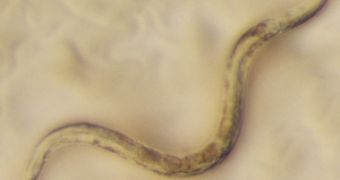Despite what you may think, biologists have a favorite worm and when they found out it got sick, they were thrilled, thinking of all the clues it can give them about human infections.
The worm in question is the nematode C. elegans, a millimeter-long worm that has been used for decades to study many aspects of biology, and researchers from the Washington University School of Medicine in St. Louis, the Jacques Monod Institute in France and Cambridge University have found that it can catch naturally occurring viral infections.
Marie-Anne Felix, PhD is a researcher who studies nematodes at the Monod Institute, and she began this study by gathering C. elegans from rotting fruit in French orchards.
She noted that some of the worms appeared to be sick, and tried to cure them with antibiotics, but obtained no positive results.
Felix thought of adopting a different technique, one that is a classic in biology experiments, so “she ground up the sick worms, passed them through a filter fine enough to remove any bacterial or parasitic infectious agents and exposed a new batch of worms to the ground-up remains of the first batch.”
David Wang, PhD, associate professor of pathology and immunology and of molecular microbiology at Washington University School of Medicine, explained that “when the new batch got sick, she knew that a viral infection was likely to be present.”
Wang's specialty is identifying new viruses, and he concluded that the worms had been infected by two viruses related to nodaviruses, a class of viruses that was known to infect fish and insects, and that so far, do not infect humans.
Additional tests showed that one of these new viruses can infect the most commonly used strain of C. elegans, so this means scientists have a good chance of studying the interaction between viruses and their hosts.
Wang said that “model organisms are essential to important steps forward in biology, and we’re eager to see what C. elegans can teach us about the way hosts and viruses interact.”
He added that several fundamental aspects of human biology were first detected in C. elegans, and later confirmed in humans, and this includes the cells' ability to self-destruct to prevent cancer, as well as RNA interference, a very important process for regulating the way genes are used to make proteins.
“We can easily disable any of C. elegans’ genes, confront the worm with a virus and watch to see if this makes the infection worse, better or has no effect,” added Wang.
“If it changes the worm's response to infection, we will look to see if similar genes are present in humans and other mammals.”
These findings appear online in PLoS Biology.

 14 DAY TRIAL //
14 DAY TRIAL //